Health Care > QUESTIONS & ANSWERS > Abdominal Final Review WCUI 2022 with complete solution (All)
Abdominal Final Review WCUI 2022 with complete solution
Document Content and Description Below
Abdominal Final Review WCUI 2022 with complete solution Which structures lies medial to the left thyroid lobes -Answer- Larynx Common cause of thyroid disorders worldwide -Answer- Graves disease, t... oxic adenoma, toxic multinodular Parathyroid glands produce hormone that affects which organs -Answer- kidneys, bones gastrointinal bone Thyroid hormones -Answer- Thyroxine (T4) and Triiodothyronine (T3), calcitonion Multiple thyroid nodules are described as _________ -Answer- Multinodular goiter (MNG) What is the thin bridge of thyroid tissue called that straddles the trachea anteriorly? - Answer- Isthmus The isthmus is the smallest portion of the gland with an AP diameter of ____ to ____ mm -Answer- 4 to 6 How many strap muscles lie along the anterior surface of the thyroid gland -Answerthree The ______ muscle is posterior and lateral to each thyroid lobe along the anterior surface of the cervical vertebrae -Answer- longus colli When thyroid hormones are needed in the body, they are released into the bloodstream by the action of the ________ which is produced in the pituitary gland. -Answer- Thyroid stimulating hormone (TSH) Thyroid stimulating hormone is regulated by ___________ which is produced by the hypothalamus -Answer- Thyrotropin-releasing hormone (TRH) Normal parathyroid glands are located _______ to the surface of thyroid -Answerposterior ______ decreases the concentration of calcium in the blood by first acting on bone to inhibit its breakdown of calcium. -Answer- Calcitonin When thyroid is producing the correct amount of thyroid hormone, it is considered to be normal, or ________________. -Answer- EuthyroidUnder secretion of thyroid hormones is called _________ and is the most commo thyroid disorder. -Answer- Hypothyroidism What are the clinical signs and symptoms of hypothyroidism? -Answer- weight gain, hair loss, increased subcutaneous tissue around the eyes, lethargy, slowing motor, cold intolerance, constipation Oversecretion of thyroid hormone results in _______. -Answer- Hyperthyroidism _______ occurs when the entire thyroid gland is not functioning properly usually from diffuse enlargement or localized nodule or adenoma causing an over-production of thyroid hormones. -Answer- Grave's Disease Clinical signs and symptoms of hyperthyroidism -Answer- weight loss, increased appetite, irritable, tremor, excessive sweating, heat intolerance, palpitations, protruding eyes (exophthalmos) The most common laboratory test to evaluate thyroid function is ___________ -Answerserum thyroxine ______ is a thyroid test that can determine its function by combining iodine uptake scan and thyroid scan -Answer- Scintigraphy The _________ thyroid scan will detect the amount of radioactive tracer to image the thyroid glad and demonstrate the thyroid size, shape & position -Answer- nuclear medicine A concentrated amount of radioactivity in the thyroid will be imaged as a ______ (hyperfunction) nodule and an lower concentration of radioactive tracer will demonstrated absence of uptake as _______ (nonfunctioning) nodule -Answer- hot, cold Hot nodules are typically ______ and cold nodules have the potential to be ______ - Answer- benign, malignant Normal sonographic appearance of the thyroid gland is fine _______ echotexture that is slightly more echogenic that the surrounding musculature -Answer- homogeneous Approximately 80% of nodular thyroid disease is due to _________ or compensatory ______ forming micronodules and micronodules of the gland -Answer- hyperplasia, hypertrophy The most common cause of thyroid disorders worldwide is ______ deficiency, which leads to nodule and goiter formation -Answer- iodineAn _______ goiter may affect large groups of people in a specific geographic area where iodine levels in the soil, food and water are low -Answer- endemic A _______ goiter is condition where nodular enlargement causes hyperactivity of the thyroid gland and hyperthyroidism. -Answer- toxic ________ goiter occurs when nodular enlargement is not associated with thyroid dysfunction. -Answer- nontoxic A __________ is a benign thyrid neoplasm that represents 5% to 10% of all nodular diseases of the thyroid. -Answer- follicular adenoma The _______ is often solitary and slow growing unless hemorrhage occurs that could cause sudden and painful enlargement. -Answer- adenoma A presence of a thin _______ ______ or halo due to compressed tissue surrounding the adenoma is consistent finding with a benign adenoma. -Answer- hypoechoic rim ________ of the thyroid is rare -Answer- carcinoma A solitary markedly hypoechoic thyroid nodule with the presence of cervical lymphadenopathy on the same side suggest ________ -Answer- malignancy The most common of thyroid malignancies is __________, which comprises approximately 70% of all thyroid cancers. affects females 3 times more often at ages 20 to 40 years of age -Answer- papillary carcinoma ________ is the second most common type of malignancy, affects females between the ages of 40 to 60 -Answer- Follicular carcinoma Follicular carcinoma usually presents as a ______ thyroid mass and may not be differentiated pathologically with FNA biopsy and may require surgical removal of the entire nodule to confirm diagnosis. -Answer- solitary Several diseases of the thyroid are characterized by _____________ of the gland causing enlargement without palpable nodule. -Answer- diffuse involvement _______ disease is an autoimmune disorder and the most common (85%) causes of hyperthyroidism. Lab test will demonstrate elevated T3 & T4 -Answer- Graves Uncontrolled acute hyperthyroidism may cause a severe complication of Grave's disease call _______, thyrotoxic crisis or thyroid storm. It usually occurs after infection and may be life threatening due to resulting hypothermia, tachycardia or heart failure - Answer- throtoxicosisThe overactivity of Grave's disease often demonstrates increased vascularity on color Doppler imaging, leading to term ___________ -Answer- thyroid inferno __________ is "a group disorders" that include inflammation of the thyroid gland with several causes such as bacteria or viral infections, postpartum, drug induced or related autoimmune abnormalities -Answer- Thyroiditis With acute thyroiditis the thyroid is _____, enlarged and may have increased color flow visualized -Answer- hypoechoic ________ thyroiditis is the most common form of thyroiditis, it is associated with a destructive autoimmune disorder, which leads to chronic inflammation of the thyroid. - Answer- Hashimoto's Parathyroid glands have 2 that lie _____ to the superior pole of the thyroid and the other 2 lie _____ to the inferior pole. -Answer- superior, posterior The normal parathyroid glands measure less than _____ millimeters (mm). -Answer- 5x3x1 The parathyroid glands produce _______ to control the serum calcium concentration using a feedback mechanism. -Answer- parathyroid hormone (PTH) When the serum calcium level __________, the parathyroid glands are stimulated to release PTH. -Answer- decrease A __________ is a benign, solid mass and the most common cause of primary hyperparathyroidism (80% to 85%) -Answer- parathyroid adenoma (PTA) ________ is an endocrine disorder caused by the increased function of the parathyroid glands affecting women 2 to 3 times more than men. -Answer- Primary Hyperparathyroidism Breast cancer screening -Answer- Age > 20 --> self breast exams Age 20 - 39 --> breast exam every 3 years Age > 40 --> breast exam annually Age 50-79 --> mammogram every year Clinical sign and symptoms of breast cancer -Answer- dominant, discrete, breast lump, unilateral single-duct nipple discharge, surface nipple lesions, nipple retraction, focal skin dimpling, red hot breast Common Primary Signs of breast cancer mammography -Answer- Irregular (Spiculated) high density mass, clustered pleomorphic, focal distortionBI-RADS Breast Imaging Reporting and Data System was implemented by which organization -Answer- American College of Radiology BI-RADS assessment for Mammographic masses -Answer- 1 - Negative 2 - Calcified fibroadenomas, multiple secretory calcification 3 -Noncalcified circumscribed solid mas 4 - Finding do not have classic appearance of malignancy 5. Classic breast cancers Ductal elements hypertrophy -Answer- gynecomastia Lymphatic glands drain to the ______ -Answer- axillary Breast extends deep towards lateral upper margin -Answer- axilla The terminal ends of the duct and acini form small lobular units referred to as ___________ -Answer- terminal ductal lobular units (TDULS) _____ connective septa within the breasts form a fibrous skeleton which is responsible for maintaining the shape and structure of breast -Answer- Coopers ligaments __________ generally appears hypoechoic, whereas Cooper's ligaments and other connective tissue appear echogenic and are dispersed in a linear pattern -AnswerSubcutaneous fat Generally, young woman have _________ tissue elements predominate and as a woman ages have a ______ tissue. -Answer- Fibrous, fatty Breast implants create _______ appearance, sometimes termed ________ -Answerechogenic, stapladder sign Malignant tumors are aggressive and tend to grow finger like extension sometimes termed ________ -Answer- spiculation Benign lessions typically are round oval, grow within tissue planes or _________ - Answer- wider than tall Malignancy lessions typically are sharp, angular margins and invade other tissue or _________ -Answer- taller than wide ___________ within a solid mass are associated with a malignancy -AnswerMicrocalcification Most common benign breast tumor and growth is stimulated by estrogen -AnswerFibroadenoma__________ causes an enlarged, reddened tender breast and is often confined to one area of the breast -Answer- Acute mastitis _________ is an inflammation of glandular tissue, typically in older women -AnswerChronic Mastitis ________ is small, benign tumor that grows within acini of breast, frequently in women 35 to 55 years of age -Answer- Intraductal papilloma Cancer of the breast has two types _____ and ______ -Answer- sarcoma & carcinoma ________ breast cancer has a tumor that arise from supportive or connective tissue; grows rapidly -Answer- Sarcoma ______ breast cancer has a tumor that arise from epithelium; in ductal & glandular tissue -Answer- Carcinoma _________ accounts for nearly 80% of breast cancer begin in ducts but spread to fatty tissue -Answer- Invasive ductal carcinoma _______ is an intraductal solid carcinoma that has duct filled with yellow paste like material -Answer- Comedocarcinoma _______ arises in the retroareolar ducts & grows in direction of nipple; spreading into intraepidermal region of nipple & areola -Answer- Paget's disease _______ intraductual tumor with extensive fibrous tissue, most common form of breast cancer & often no histologic pattern -Answer- Scirrhous carcinoma _________ is a densely cellular tumor that contains large, round tumor -Answermedullary carcinoma Normal size of testes -Answer- 4cm length x 2 diam x 3 wide Epidiymis is divided into what three parts -Answer- head, body & tail Testis is completely covered by dense, fibrous tissue called ________ -Answer- tunica albuginea The _________ lines the inner walls of the scrotum, covering each testis and epididymis. -Answer- tunica vaginals Common spot for fluid to collect in testis -Answer- Between partietal & visceral layer or the tunica vaginalsThyroglossal duct cyst is a palpable mass _______ midlines between hyoid bone - Answer- anterior Hyperfunction of all parathyroid glands with no apparent occurs with which one of the following -Answer- primary hyperplasia of parathyroid gland Which disease is marked with increased vascularity with color Doppler and is termed thyroid inferno -Answer- Graves disease Abnormal lymph nodes demonstrate __________ -Answer- round contour Sonographic appearance of normal testis -Answer- homogenous with medium level echoes Epididymis courses _______ & _______ to testis -Answer- superior & posterolartally Which one of the following may transpire 2nd to epididymites in testis -Answer- orchitis Intratesticular cysts have association with _________ -Answer- spermatoceles Microlithiasis of testis is associated with _______ -Answer- malignant neoplasm _______ is by the superior pole of testis between epididymis and testis -AnswerAppendix testis _______ is "not considered a cancer" -Answer- lobular carcinoma in situ Microlithiasis is not considered to be abnormal unless more than ___ appear on single image -Answer- 5 The ______ is a fibrous band that stretches from the xiphoid to the symphysis pubis - Answer- linea alba The retroperitoneal cavity contains the _______, ______, ureters, _______, aorta, IVC, bladder, uterus & prostate gland -Answer- pancreases, kidneys, adrenal glands The ________ pararenal space is located between the anterior surface of the renal fascia (Gerota's fascia) and the posterior area of the peritoneum. -Answer- Anterior The most common renal neoplasm affecting the IVC is ________ usually from the right kidney -Answer- renal cell carcinoma The ______ is formed posterior to the pancrease by the union of the SMV and splenic veins. -Answer- portal veinThe liver receives a dual blood supply from the ____ and _____ -Answer- portal vein & hepatic artery Peritoneal Cavity -Answer- Liver is in what cavity? Posterior Superior surface of the medial left lobe, bordered by IVC psteriorly -AnswerWhere is caudate lobe located? Falciform Ligament -Answer- Divides liver into Rt and Lt lobes. Ligamentum Teres/Round Ligament -Answer- Divides the left lobe into medial and lateral segments. Ligamentum Teres -Answer- Remnant of the umbilical vein extending from umbilicus to the left portal vein. Ligamentum Venosum -Answer- Remnant of the ductus venosum. (fetal circulation shunt) Subpherenic Space -Answer- What is the space between the diaphragm and the liver called? Portal Triad -Answer- Group of structures is surrounded by Glisson's Capsule, w/c accounts for echogenecity of this region. CBD,Hepatic Artery and Portal Vein -Answer- What are the vessels in Portal Triad? Splenic Vein and SMV -Answer- Portal vein is confluence of ________________ and _____________________. Portal Vein -Answer- Echogenic walls, hepatopedal, low velocity, low resistance, continous flow, horizontal positioning and intra segmental. Hepatic Vein -Answer- Thin walls, hepatofugal, high resistance, pulsatile and tri-phasic, vertical positioning, and intersegmental Kupffer Cells -Answer- Excretory function, detoxification, Phagocytosis Lab Values for liver -Answer- AST, ALT, ALP, AFP, Bilirubin, Hematocrit, Leukocytosis, Prothrombin Time and Serum Proteins Alanine Amino Transferase -Answer- High levels of _______________________ in the blood can indicate a liver problem, even before you have signs of liver disease, such as jaundice, a condition that causes your skin and eyes to turn yellow.Liver Disease -Answer- An ALT blood test may be helpful in early detection of _________________________.. Alkaline Phosphatase -Answer- High _____________________________ usually means that either the liver has been damaged or a condition causing increased bone cell activity is present. Hematocrit Level -Answer- test measures the proportion of red blood cells in your blood. Red blood cells carry oxygen throughout your body. Having too few or too many red blood cells can be a sign of certain diseases. Leukocytosis -Answer- refers to an increase in the total number of WBCs due to any cause. Prothrombonin Time -Answer- Your doctor might order this test to check for a bleeding disorder. Serum Protein Electrophoresis -Answer- test measures specific proteins in the blood to help identify some diseases. Chronic Cellular Damage -Answer- What do elevation of AST indicate? Enzyme release from the liver damage disease -Answer- What do elevation of ALT indicate? Hepatoma/Hepatoblastoma -Answer- What do elevation of alkaline phosphatase (ALP)indicate? Jaundice -Answer- What does the elevated total bilirubin indicate? Biliary Tract Obstruction and Hepatocellular Disease -Answer- What does the elevated direct bilirubin indicate? Hemolytic Disease -Answer- What does the elevated indirect bilirubin indicate? Hepatoblastoma -Answer- A rare malignant germ-cell tumor. The most common malignant liver tumor that occurs in infancy and childhood. Portal Hypertension -Answer- Increased pressure in the PV as a result of obstruction of the flow of blood through the liver. Stage1-Necrosis, Stage2-Regeneration and Stage3-Fibrosis -Answer- Stages of Cirrhosis. Cirrhosis -Answer- Progressive/irreversible disease of the liver.Hydatid/Echinoco Cyst -Answer- Parasite most often causing disease in humans Fundus, Neck and Body -Answer- What are the parts of GB? Inside the cystic duct -Answer- Where are the 2 normal variants? <5 mm -Answer- What are the normal measurement of CBD? Concentrates, Stores and Transport -Answer- What are the functions of the GB? Acute Cholecystitis -Answer- Inflammation of the GB wall Adenoma -Answer- Benign epithelial cell tumor representing localized overgrowth of the lining epithelium. Polyps -Answer- Adenoma AKA _____________. Most common benign neoplasm. Klatskin Tumor -Answer- A rare carcinoma of the intrahepatic bile duct specially at hepatic hilum. Pancreatic Duct > Prox CBD. Cystic Duct >GB Dilation (Hydrophic Mucocele, CBD Dilation Intrahepatic Duct -Answer- List the structures that will be associated (dilated) with the obstruction of CBD. Retroperitoneal -Answer- Whereis the pancreas located? Wirsung Duct -Answer- What is the another name of the pancreatic duct? Head, Body Tail -Answer- Define the pancreatic subdivision. GDA, SMA and Splenic Artery -Answer- Which vessels provide blood flow to the pancreas? GDA and CBD -Answer- Vessels are present in the head of the pancreas. Exocrine and Endocrine -Answer- Pancreas performs both ______________ and ____________ functions. Exocrine -Answer- secretes hormones Lipase, Trypsin, and Amylase -Answer- What are the exocrine products of the pancreas? Amylase -Answer- Breakdown complex carbs. Islets of Langerhans -Answer- Which cells perform the endocrine functions?Alpha Cells, Beta Cells and Delta Cells -Answer- What are the endocrine products of the pancreas? Alpha Cells -Answer- Secretes glucagon stimulates the liver, convert glycogen to glucose. Beta Cells -Answer- Stimulates cell receptors to open and receive glucose. Cholecystokinin -Answer- Stimulates secretion of pancreatic enzymes relaxation of intestinal sphincters and GB contraction. Renal Cortex, Medulla and Renal Pelvis -Answer- What are the 3 subdivisions of the kidney? Renal Pelvis -Answer- Which is the most echogenic portion of the kidney? Medulla -Answer- Which is the darkest part of the kidney? Gerota's Fascia, Fibrous Capsule and Pararenal Fat -Answer- What are 3 surrounding layers of the kidney? Blood Vessels, Peripelvic Fat, Nerves, and Lymphatics -Answer- What are the contents of renal sinus? What is the normal size of the kidney -Answer- 9-13 cm length, 4-5 wide, 2-3 thick Urine Test, Pyuria, Proteinia, PH level of the urine, BUN and Serum Creatinine - Answer- What are the lab values for abnormal renal functioning/failure? Excretion of waste, Urine Production, it influence blood pressure, regulation of acid base/electrolytes ions, and control blood concentration -Answer- What are the functions of kidney's? <0.5 to 0.7 -Answer- What is the normal resistive index? Adult Polycystic Kidney Disease -Answer- A genetic disorder. Associated with Burry's aneurysm Multicystic Dysplastic Kidney -Answer- Most common childhood renal cystic disease. Multiple renal cysts of variable size are typical w/ largest ones usually peripheral. Hydronephrosis -Answer- Dilation of renal collecting system caused by obstructive outflow of the urine. Hypernephroma -Answer- RCC AKAAngiomyolipoma -Answer- Common benign neoplasm composed of angiolipotoma composed of fat, blood, vessel and smooth muscle fibers. Lymphatic Systems and IVC -Answer- Define the ways cancer can mestatisize from kidney. Perinephric fat, Gerota's Fascia, Renal Vein, IVC, Heart, Lymph Nodes, and Adjacent structures (Adrenal gland, spleen, liver contralateral kidneys) -Answer- Name the various locations of invasion of the metastasize from the kidneys. 24-72 hrs to define texture, size, blood flow and fluid collection -Answer- What does the baseline examination include for transplanted kidney? Anterior Superior and medial to the Kidney bilateral -Answer- Where is the location of adreanl glands? RetroPeri -Answer- Is adrenal glands retro or peritoneal? Aldestrone, Cortisol and Estrogen/Androgen -Answer- Which are the hormones produced by the cortex of adrenal gland? Epinephrine and Non Epinephrine -Answer- Which are the hormones produced by the medulla of adrenal gland? Addison's Disease -Answer- List the diseases caused by the hypoadrenalism. Atrophy -Answer- Addison's disease is due to __________ of the gland. Cushing's Syndrome, Conn's Syndrome, and Pheochromacytoma -Answer- List the diseases caused by hyperadrenalism. Cushing's Disease -Answer- Caused by the pituitary tumor or adrenal corticol tumor. Conn's Disease -Answer- Caused by too much aldesterone-benign tumor Pheochromacytoma -Answer- Tumor arises from medulla and causes sustained hypertension, headaches, sweating, tachycardia, anxiety nausea, and vomiting. Phagocytosis -Answer- Filters blood damage cells and amino organism Tunica Intima, Media and Externa -Answer- List the 3 layers of an artery/ Bi-Phasic Flow -Answer- What are type of blood flow is present in aorta?Celiac Axis, SMA, Renal Artery, Gonadal Artery and IMA -Answer- What are the branches of abdominal AO (cephalad to caudal) and which structures receive blood form them? Celiac Axis -Answer- The artery supplies blood to liver, stomach, spleen and pancreas. SMA -Answer- The artery supplies blood to small intestine, cecum, asc. colon, pancreas and hepatic flexure. Renal Artery -Answer- The artery supplies blood kidney, ureters, adrenal glands. Gonadal Artery -Answer- The artery supplies blood to ovaries/testicles. common hepatic artery -Answer- Liver get the blood supply from what artery? Lt. Gastric Artery -Answer- Stomach get the blood supply from what artery? Splenic Artery -Answer- Spleen and pancreas get the blood supply from what artery? SMA and IMA -Answer- Which artery has dual resistance in our body and when does it changes its resistance of blood flow? Low Resistance -Answer- SMA/IMA resistance after eating? Distal IVC -Answer- What vessel is anterior to to spine and ascends in the abdomen to the right of the abdominal AO. Does the distal IVC has pulsatile or phasic flow? -Answer- phasic IVC -Answer- The following veins drains to ___________________. CIV, Rt GV, Rt and Lt Renal V, Hepatic V and Rt Adrenal V Fusiform -Answer- A true aneurysm. Uniform dilation of all 3 layers of an artery. Saccular -Answer- Focal outpouching on one side of the vessel wall. Lt. CIA -Answer- What is the most common location of Saccular Aneurysm? Intrarenal -Answer- What is the most common location of Fusiform Aneurysm? Dissecting Aneurysm -Answer- occurs when intimal lining of the arterial wall tears and allow the blood to flow between intima and media causing inflammation. Thoracic Region -Answer- What is the most common location of Dissecting aneurysm?Pseudoaneurysm -Answer- Fasle aneurysm. These aneurysm do not have a wall. Surrounded by clot. T3, T4 and Calcitonin -Answer- Which hormones are produced by thyroid gland? T3 and T4 -Answer- Stimulation growth of the body Calcitonin -Answer- Balances calcium/blood level Parathormone -Answer- Which hormone is produced by parathyroid gland? CCA and IJV -Answer- The lateral borders of the thyroid glands? Strap Muscle -Answer- The anterior border of the thyroid glands? Longus Colli -Answer- The posterior borders of the thyroid glands? Multinodular and Hashimoto Thyroiditis -Answer- List the diseases caused by hypothyroidism. Grave's Disease, Thyroid Cysts, and Follicular Adenoma -Answer- List the diseae caused by the hyperthyroidism. Mucosal, Submucosal, Muscularis, Serosal, and Mesothelium -Answer- What are the layers of the GI tract?(from innermost to outermost) Head, Body and Tail -Answer- What are the portions of epididymis? Hydrocele -Answer- Abnormal accumulation of fluid in the tunica vaginalis. Varicocele -Answer- Enlargment of the veins of the seromatic cord that will cause infertility. Hematocele -Answer- Blood in serotal sac because of injury or surgery. Spermatic Cord Tosion -Answer- The spermatic cord w/c is composed of arteries, veins, vas deferens, nerves and lymphatic ducts is twisted and cut off the blood supply to the testicle. Subcutaneous, Mammary, and Retromammary -Answer- What are the layers of breast? Fibradenomas -Answer- What is the most common benign breast mass? Infiltrating Ductal Carcinoma, Medullary Carcinoma and Infiltrating lobular Carcinoma - Answer- List the malignant masses of the breast.A Stone -Answer- Intraluminal echogenic structure casting a distal acoustic shadow. gravity dependent and moves or float. Posterior shadowing Hemorrhage, Urinoma, Lymphocele and Abscess -Answer- List the fluid collections in the retro peritoneal cavity. Hepatopedal -Answer- Flow toward the liver Hepatofugal -Answer- Flow away the liver Hyperglycemia -Answer- Uncontrolled increase in glucose Porcelain GB -Answer- Calcification of the GB wall Hydropic GB -Answer- Hydrops occurs with distention of the GB Santorini Duct -Answer- A variant or accessory pancreatic duct Ampulla of Vater -Answer- Small opening in the duodenum in which the pancreatic and CBD enter to release secretions retroperitoneum -Answer- space behind the peritoneal lining of the abdominal cavity vas deferens -Answer- tube that connects the epididymis to the seminal vesicle rete testis -Answer- network of tubules between the seminiferous tubules and the epididymis ureterocele -Answer- a dilated distal portiob of ureter seen in the bladder. maybe unilateral or bilateral Courvoisier's sign -Answer- it's enlarged non diseased GB associated w/ an extrinsic obstruction of the distal CBD McBurneys point -Answer- site of maximal tenderness in the RLQ; usually appendicitis located by drawing a line from the right anterosuperior iliac spine to the umbilicus at approximately the midpoint of thisbline lies the rootof the appendix. Positive Murphy's sign -Answer- focal tenderness over the GB Exopthalmus -Answer- bulging eyes, often from thyroid disease due to Graves disease tunica vaginalis -Answer- The delicate layer of serous membrane that covers the testis is called thepampiniform plexus -Answer- a network of testicular veins that drain the testes and absorb body heat from the testes and scrotum cyptoorchidism -Answer- undescend testicles risk for cancer Valsalva maneuver -Answer- forcible exhalation against a closed glottis, resulting in increased intrathoracic pressure [Show More]
Last updated: 1 year ago
Preview 1 out of 36 pages

Reviews( 0 )
Document information
Connected school, study & course
About the document
Uploaded On
Jan 09, 2023
Number of pages
36
Written in
Additional information
This document has been written for:
Uploaded
Jan 09, 2023
Downloads
0
Views
109



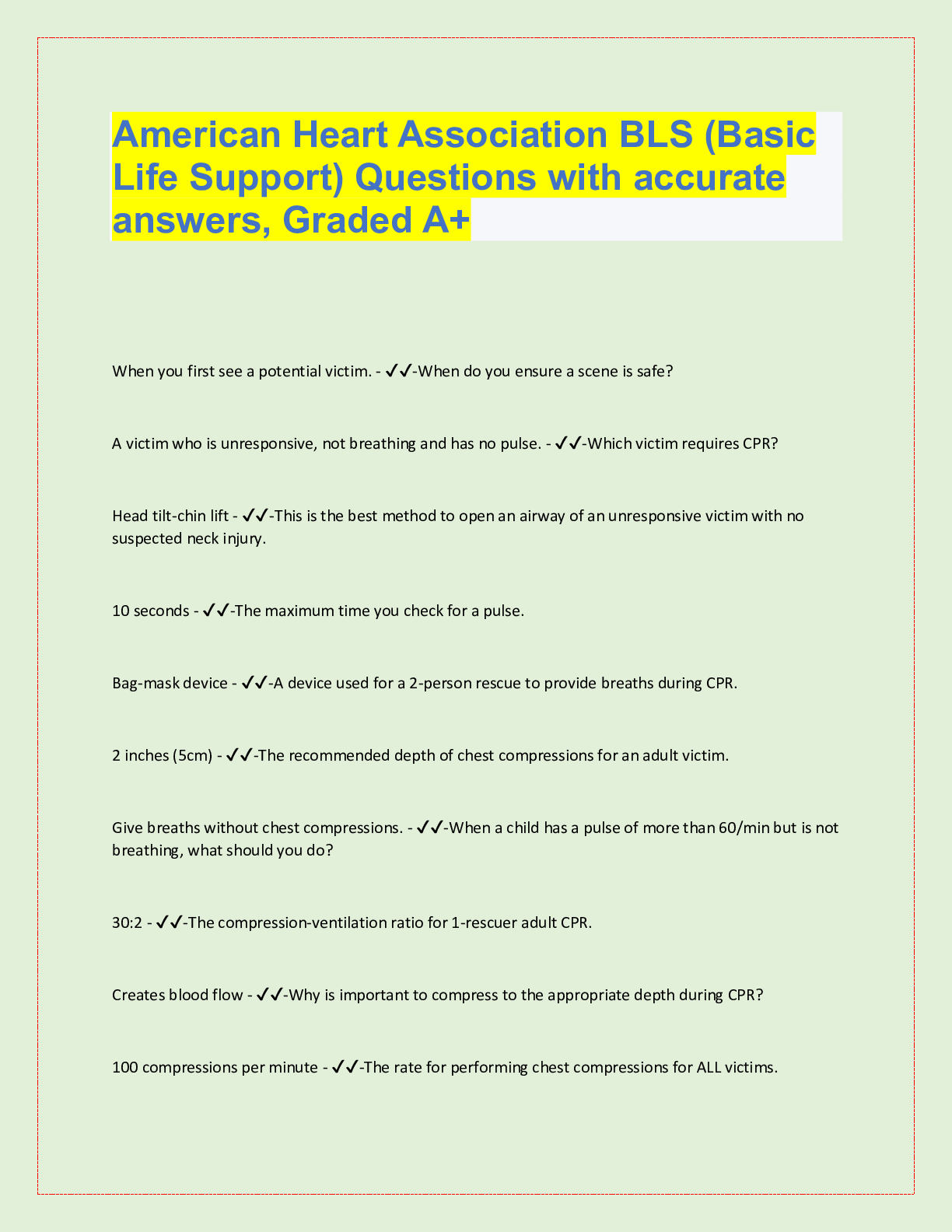


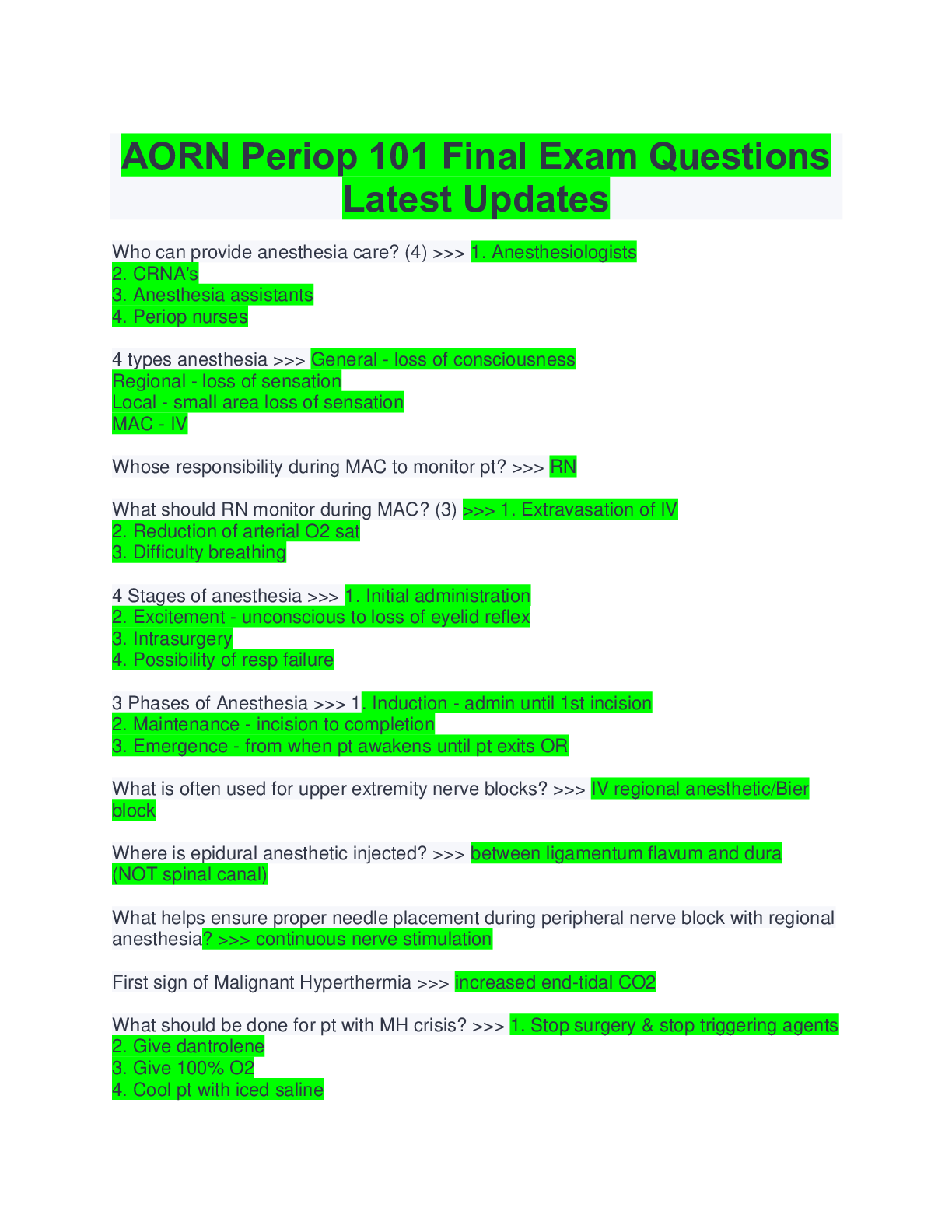






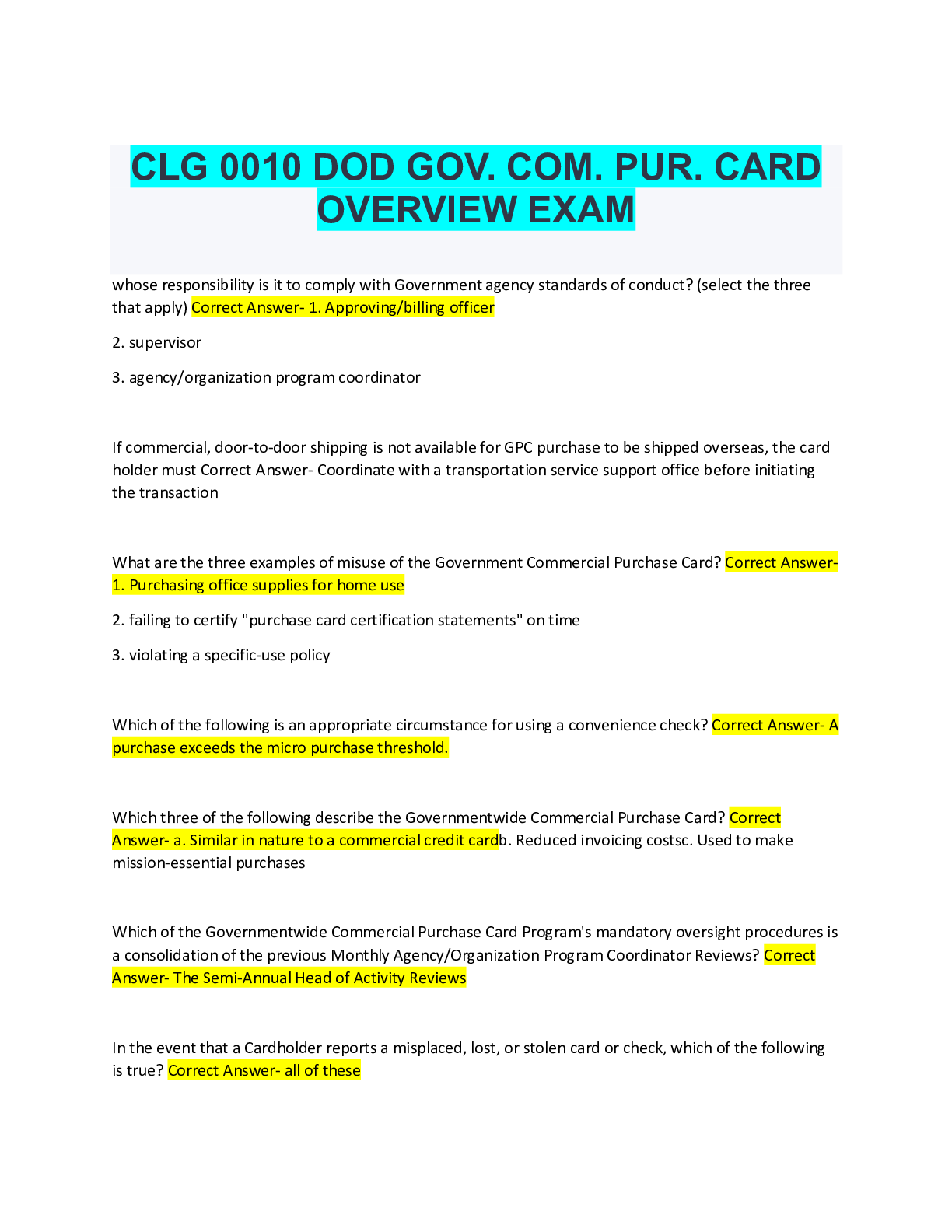


.png)
.png)
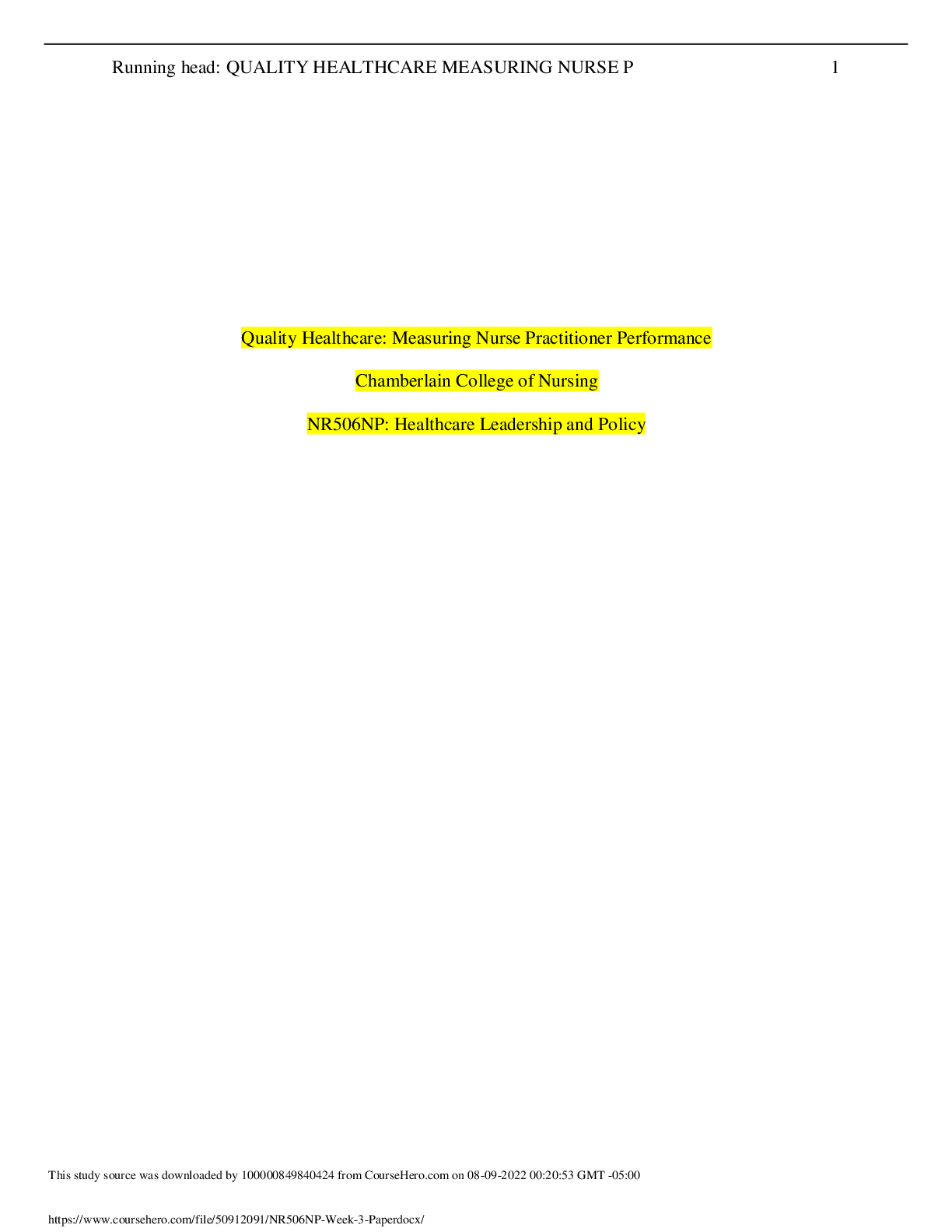
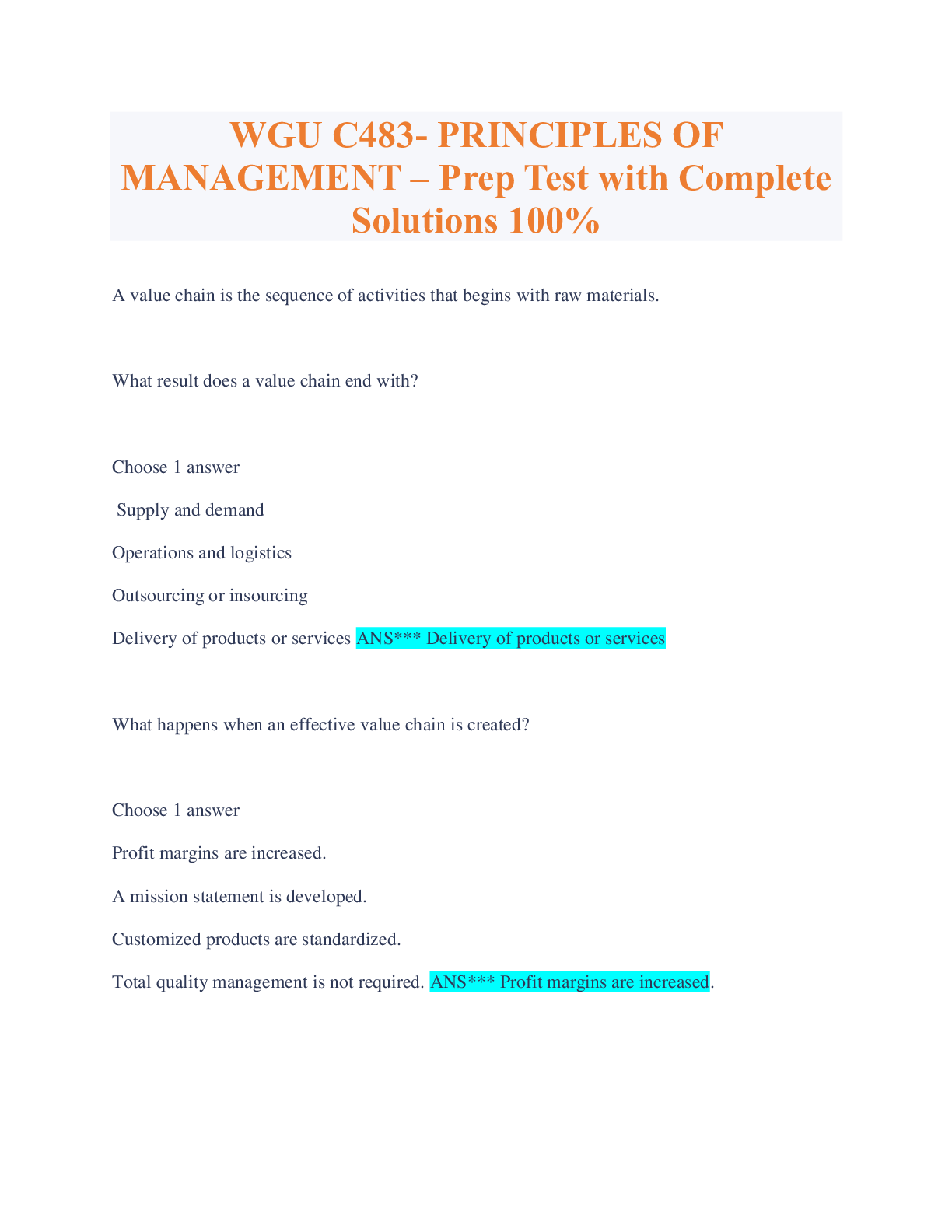

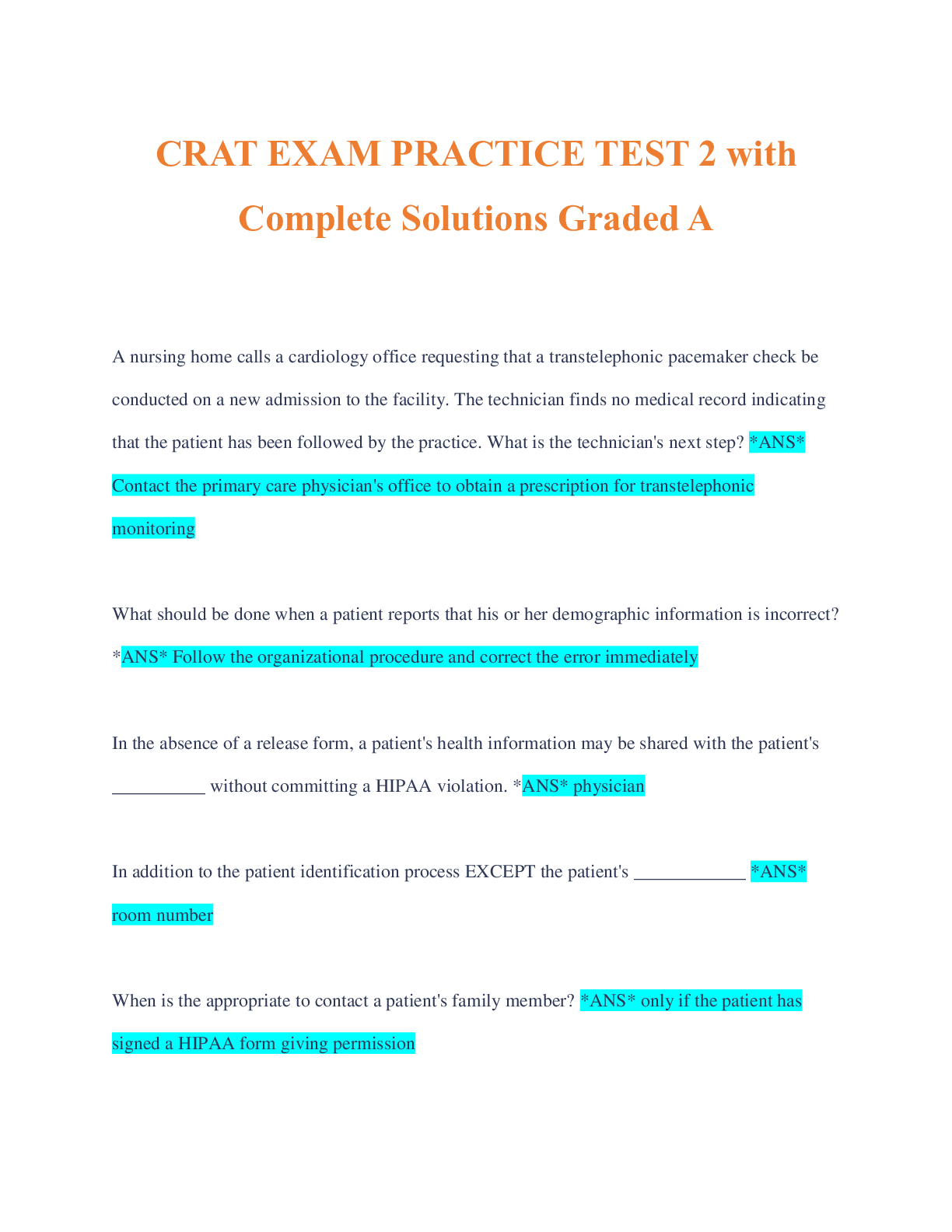
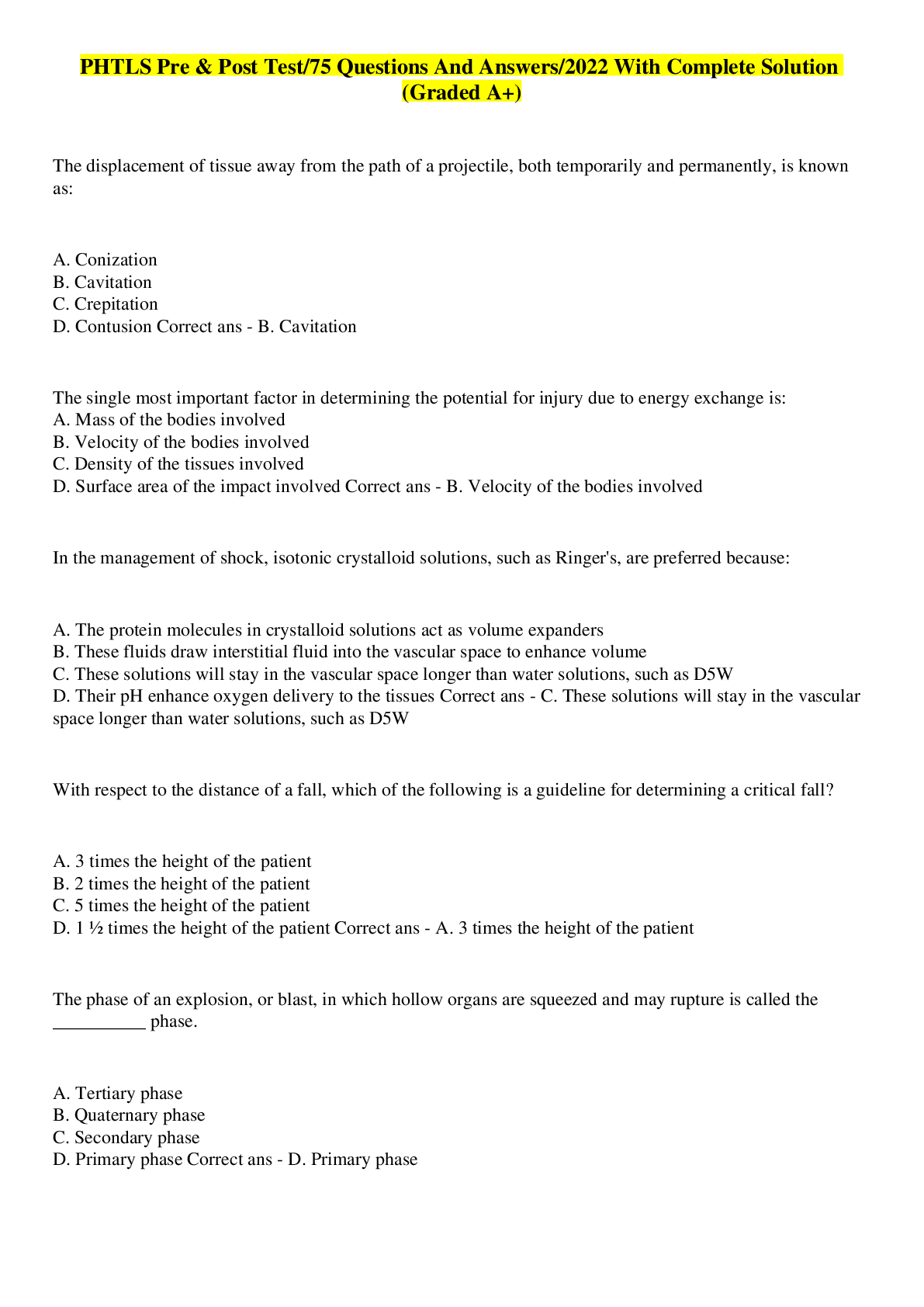
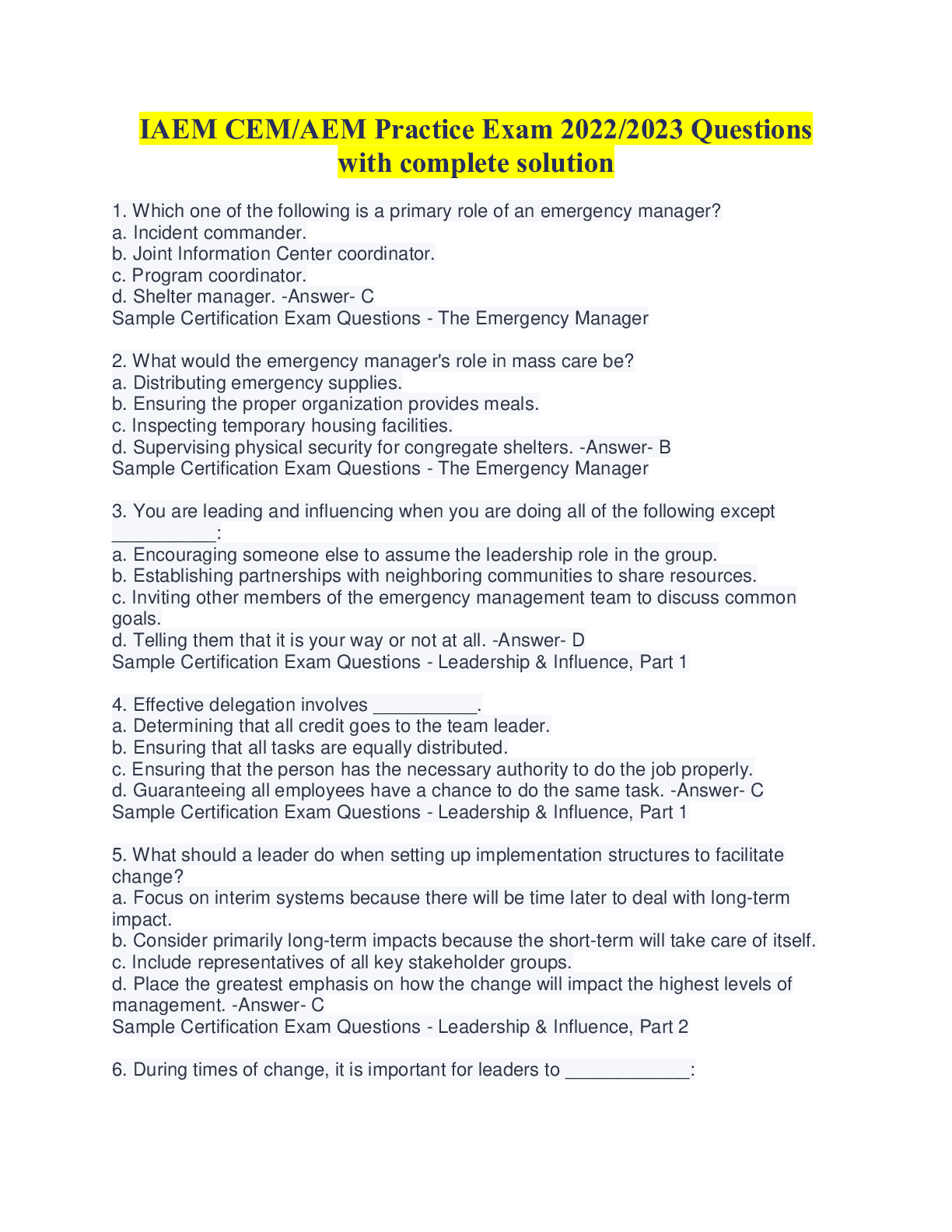
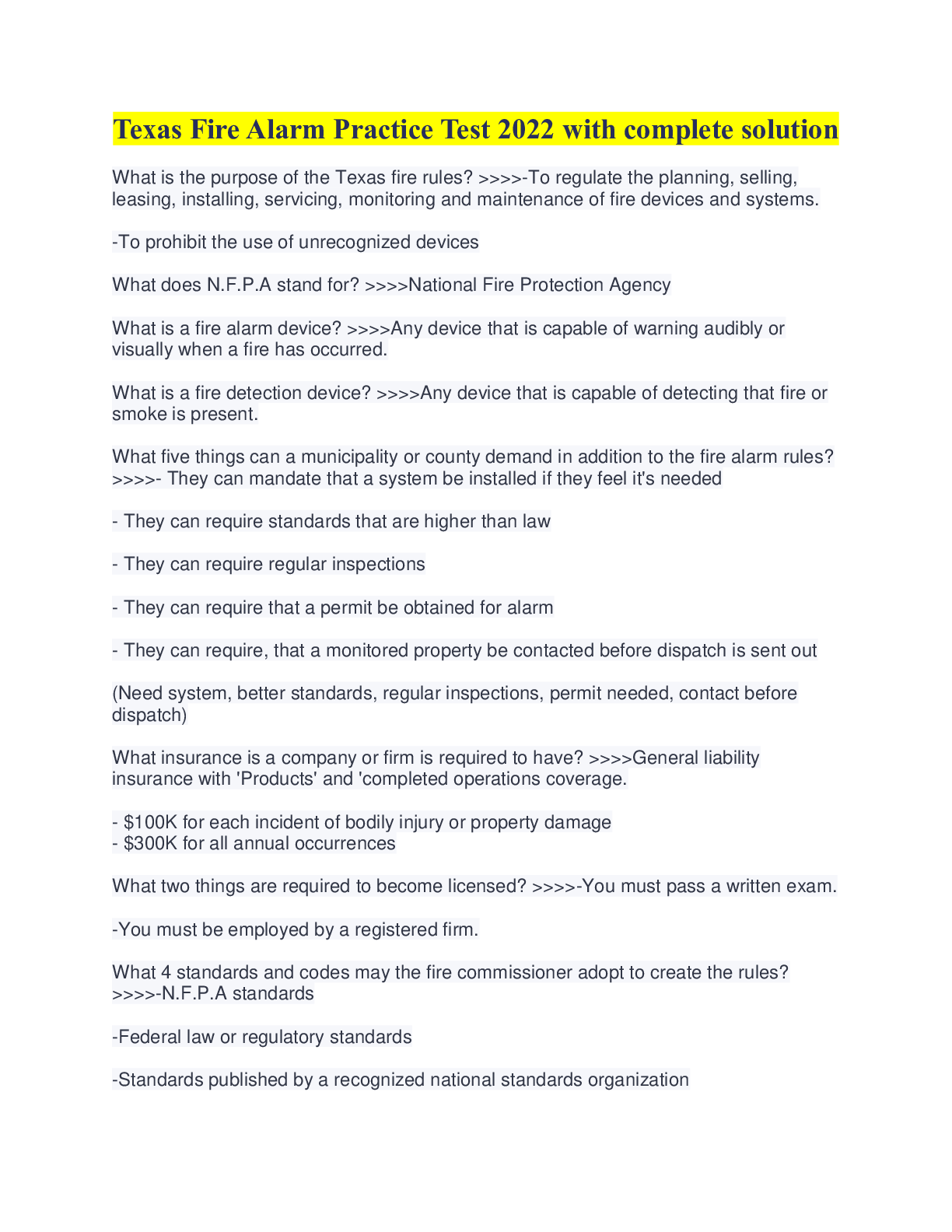
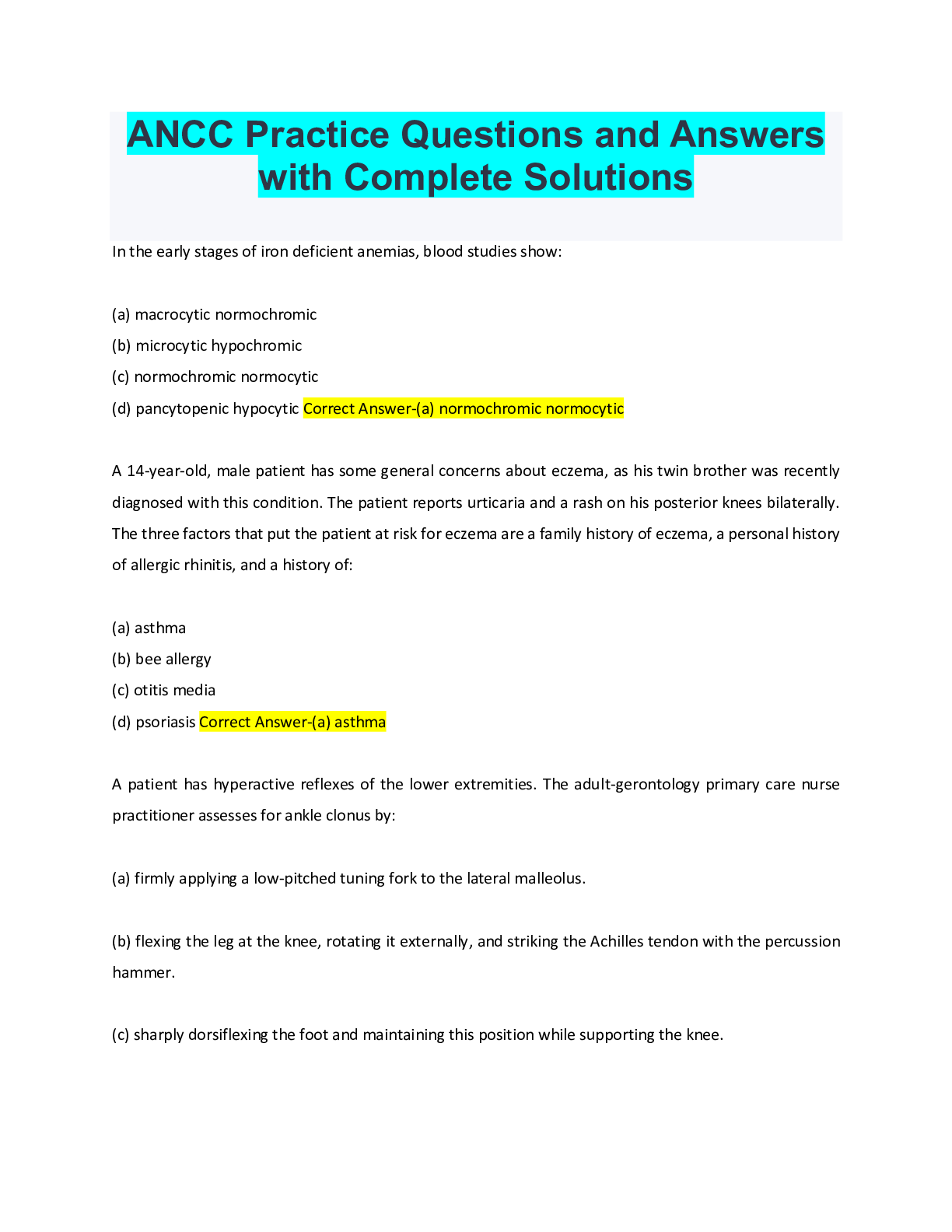
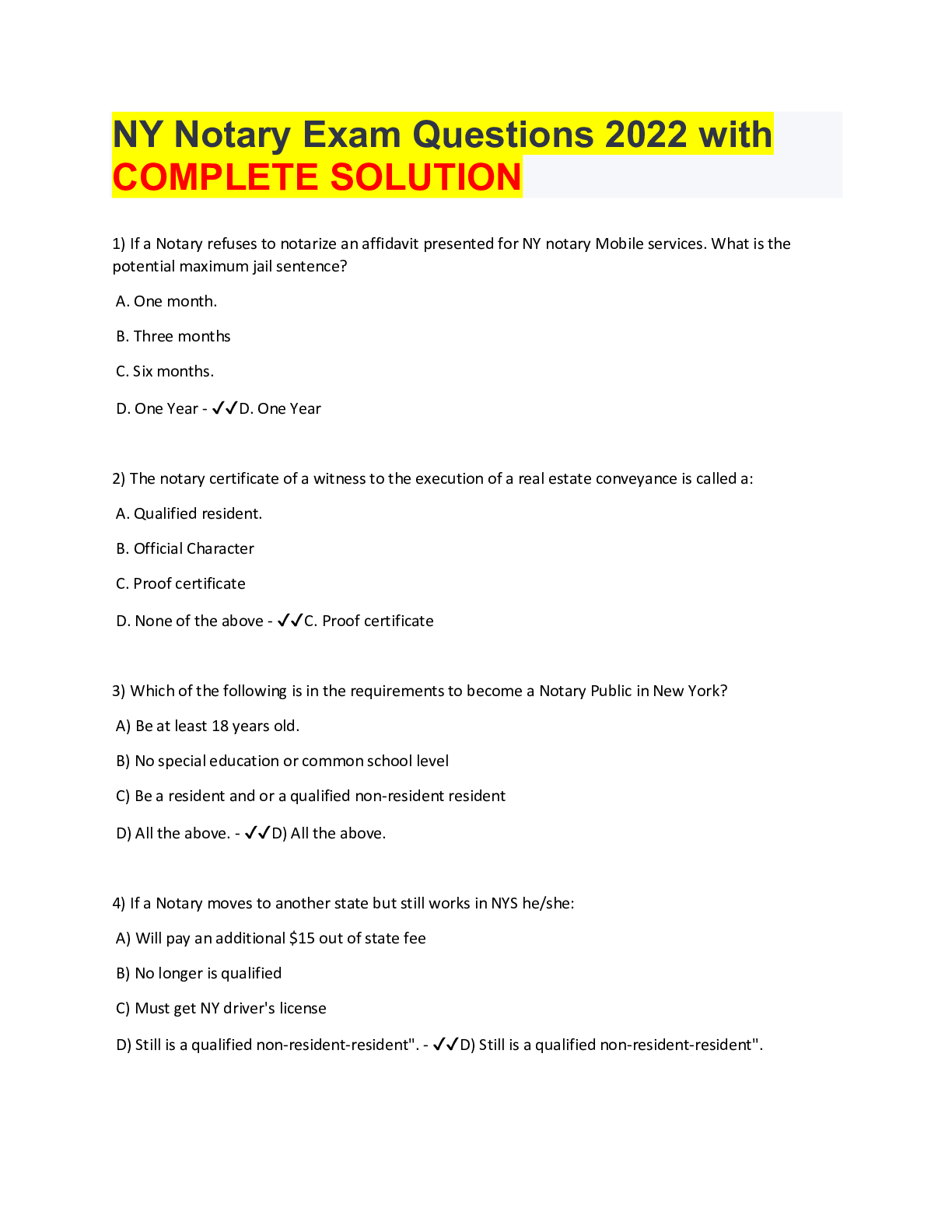
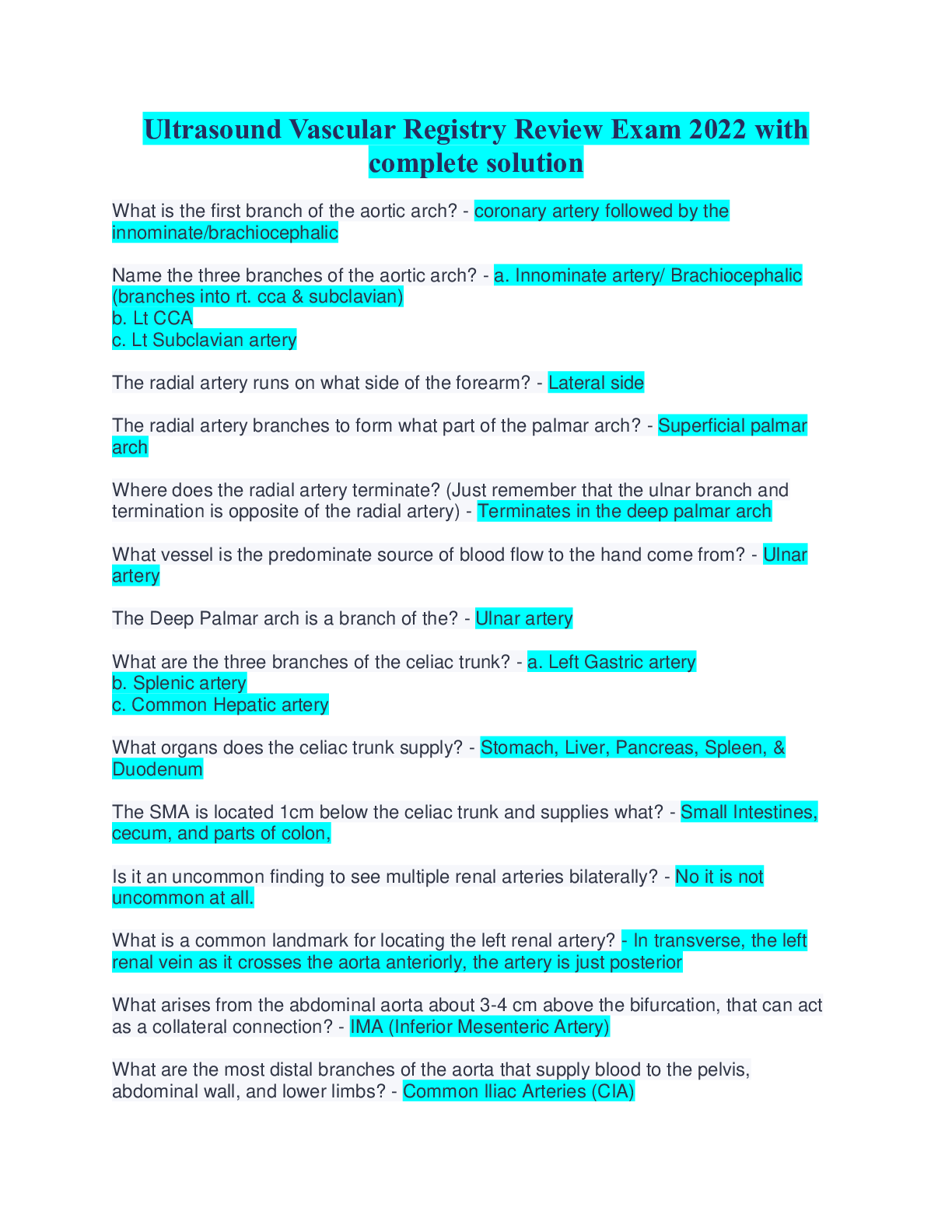
.png)
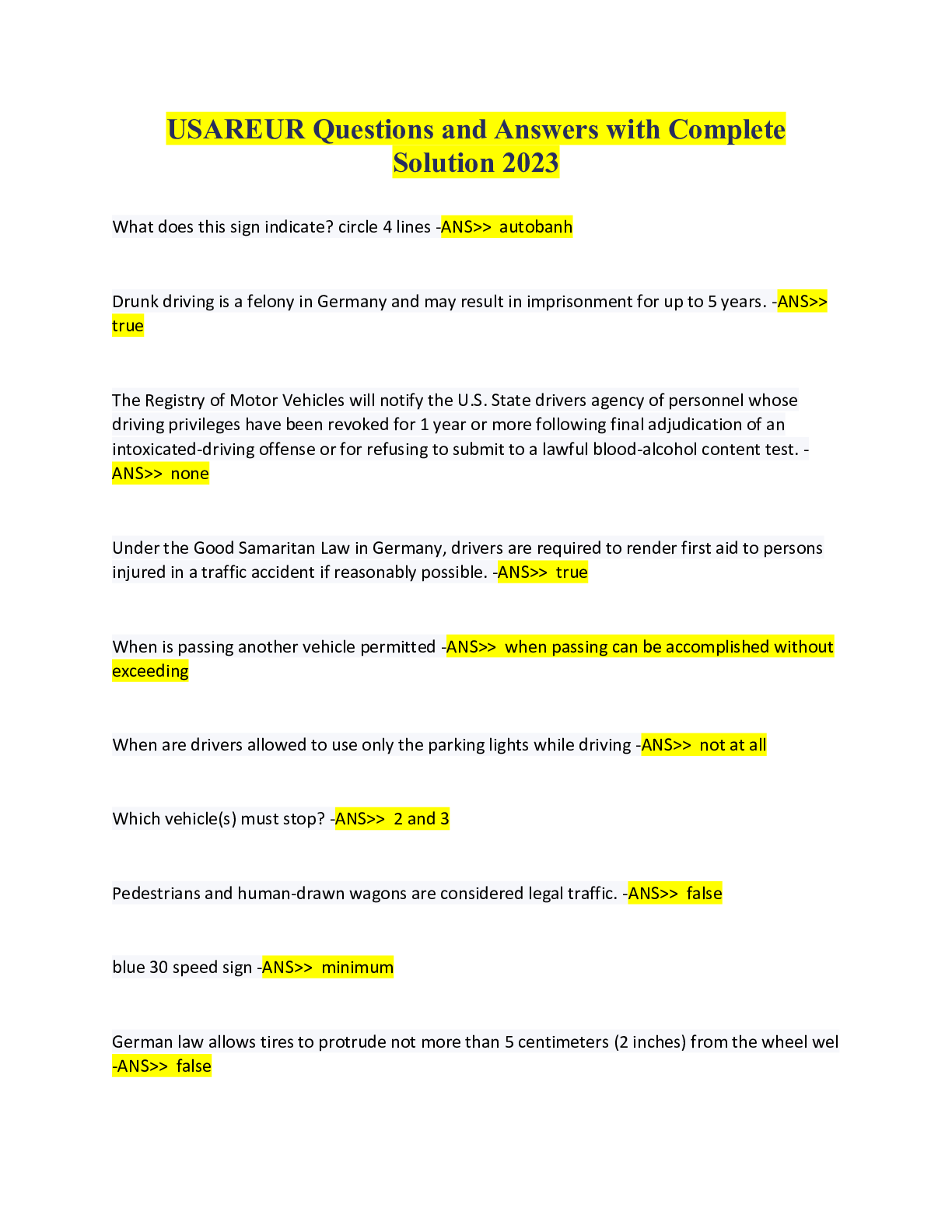
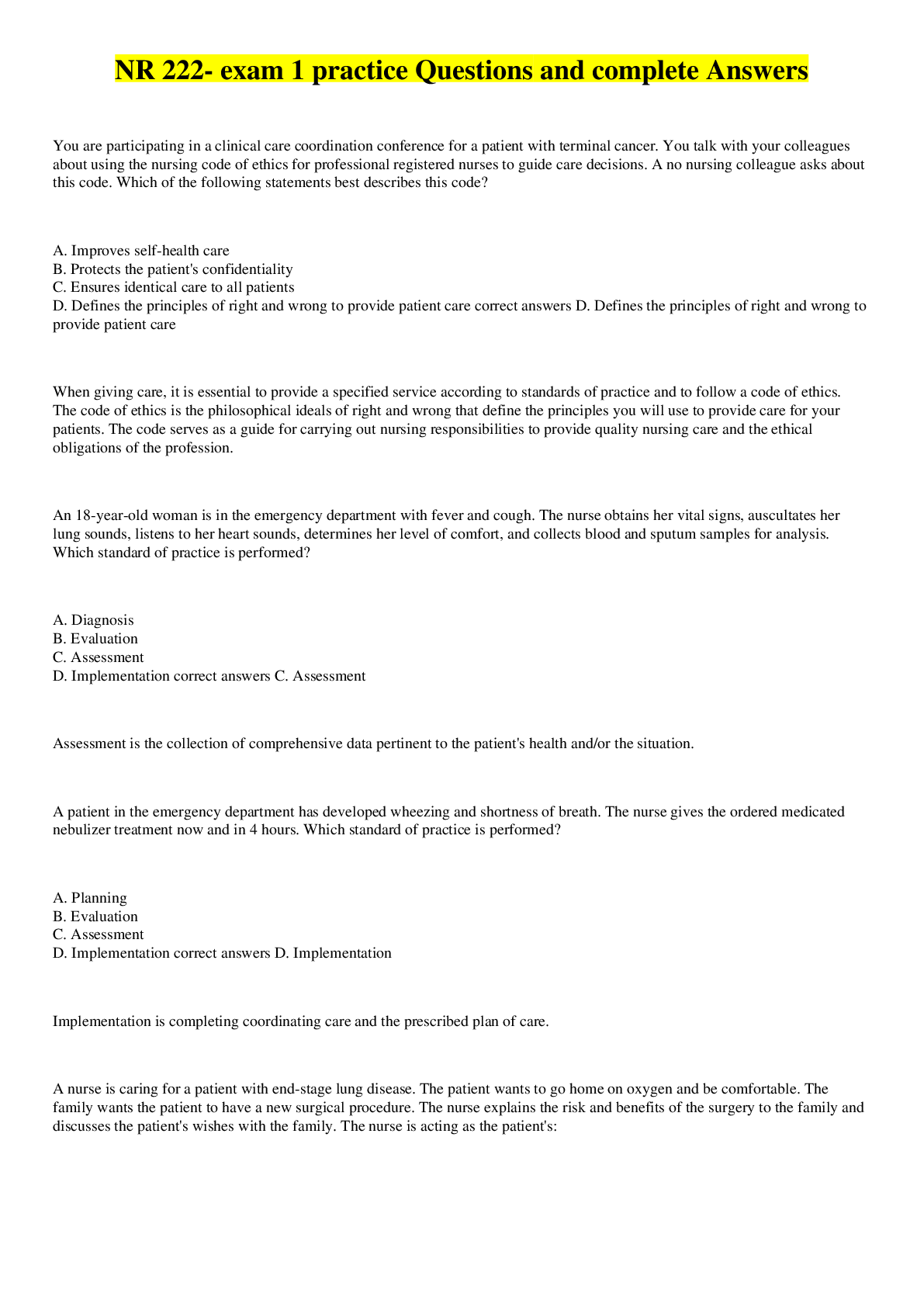
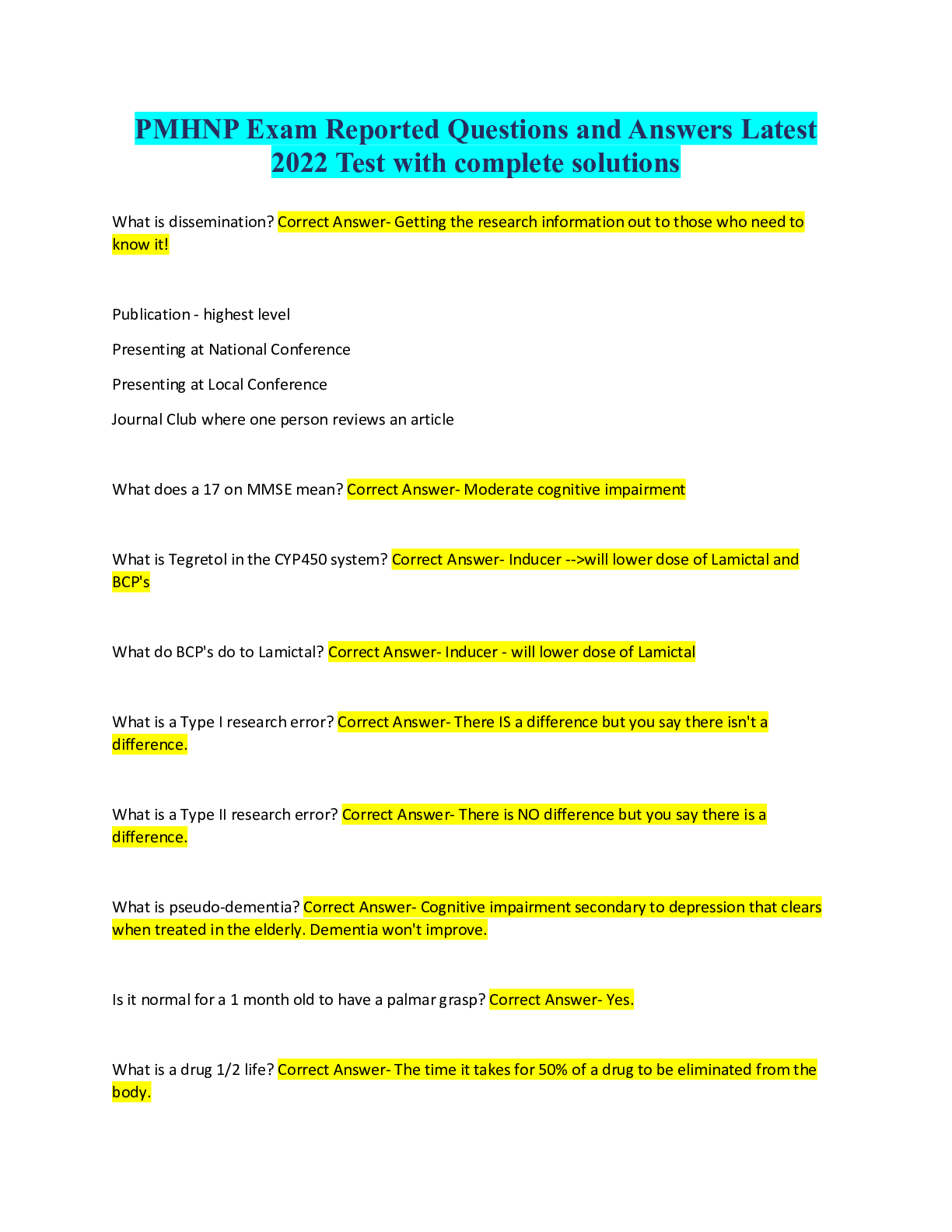
.png)
.png)

